For the second instalment of our Warsaw series, we would like to take you with us on an ‘Off the Beaten Track’ tour with Adventure Warsaw, to unveil the soul of this extraordinary city.
Warsaw and its history
Warsaw is an odd city. It’s not particularly pretty, at first glance. It is a city that cannot be understood, unless one knows history. It’s a place where beauty is not in the obvious, and stories are not out in the open. A place that reveals itself only to those who have time to search for stories.

Usually, when that’s the case, we like taking a tour. We loved the sound of the Adventure Warsaw’s tour, focused on Warsaw’s history over the course of the twentieth century. So, one sunny morning, we set off in a bright blue Soviet era van, with our guide Adam, a Warsaw local.
Our Adventure Warsaw Tour
Our first stop was Grzybowski Square, which, once again, at first glance didn’t look like much. ‘Listen to the city’ Adam said. ‘Look at the buildings. The city wants to tell you a story’.

We looked around, helped by Adam, and saw what he meant. Over one hundred years of history, stories and people’s lives, crossing paths in the same square. Wealthy pre-war buildings, with ornate windows and façades; stocky and functional Socialist blocks of flats, and the cathedrals of capitalism, all glistening steel and glass.
A few steps away, we reached the last street of the Ghetto, Ulica Próżna. The four remaining houses are being restored now, but Adam led us around the back, where it was possible to see into the old courtyards. The buildings had been constructed as homes for the wealthy; Adam pointed out details we never would have noticed, such the ornate bollards on the entrance to prevent coal-carts from ruining the beautiful doorways, and hooks to tie the horses.
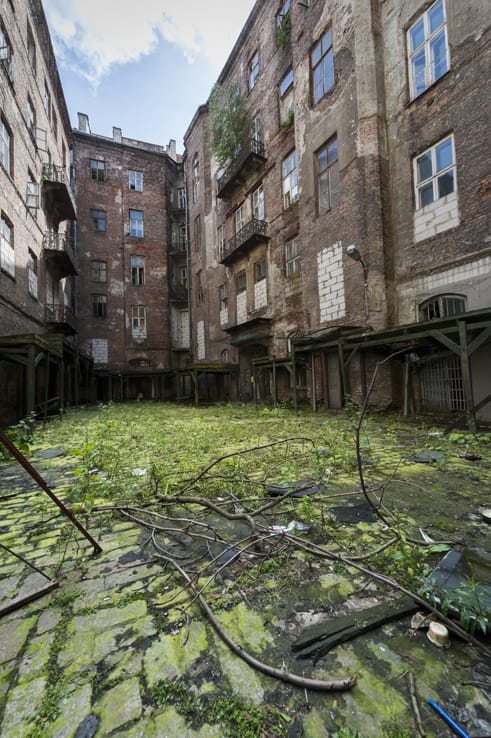
We learnt of the tragedy of the Ghetto. I thought it was strangely prophetic that Ulica Próżna is translated as ’empty street’, for it was empty indeed; empty but not silent, if one knew how to listen.
Soviet Warsaw
Before reaching our next stop, Adam drove past the Palace of Culture and Science, the Soviet-style extravaganza that still dominates Warsaw’s skyline. ‘Normally, where there are two Poles, there are three opinions’ Adam joked. ‘Some people think the Palace is beautiful. Others hate it. But even those who hate it agree there’s a beautiful view from the top. Because that’s the only place where you can’t see the Palace itself’.
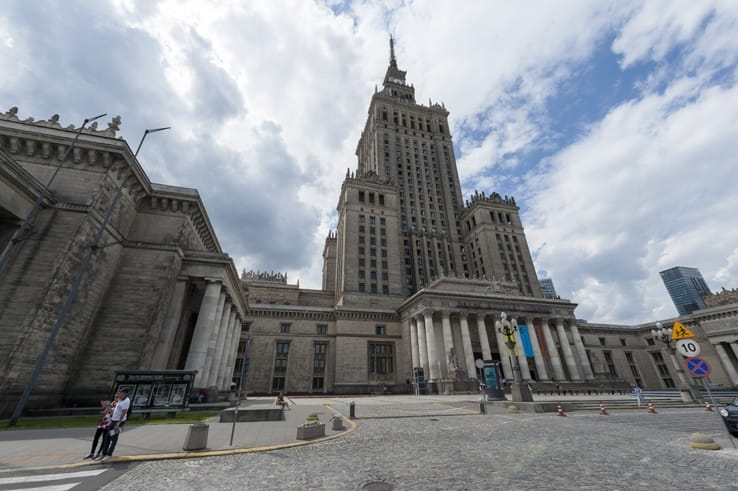
Adam stopped the van in a quiet backstreet. I was wondering what was so interesting about it, before Adam suggested again to listen to the city. We wandered into a courtyard, and then another, and another. All three had a small shrine with the Virgin Mary in it.
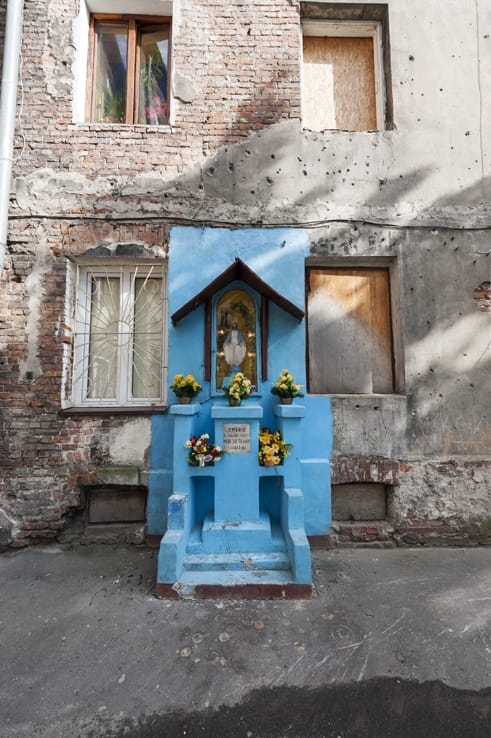
They were set up during the War, sometimes in the centre of the yard, other times hidden in the gate or staircases. Public gatherings were prohibited, and the atmosphere was of terror, with dissidents being deported on a daily basis. These shrines were a way for people to gather in prayer, to find faith while the city was crumbling around them.

Some of these pre-war buildings were in terrible condition, poorly maintained, some even still riddled with bullet holes. That is because their ownership is not clear, Adam explained. The original owners may have died in the War, but their heirs might survive, elsewhere in Europe, the US or Israel. No one wants to face the costs of renovating the buildings, as the heirs may turn up, one day or another.

Praga, Warsaw’s bohemian neighbourhood
After showing us the stunning Polytechnic building, Adam drove us across the river to the suburb of Praga. The name has nothing to do with Prague; it originates from the old Polish word for burning, referring to a forested area that was burnt to make way for the village. There were far more pre-war buildings in Praga compared to the city centre. This area was where the Red Army was stationed, and it was spared the destruction of the centre after the Warsaw Uprising.

We had lunch in a milk bar, a type of establishment that was popular throughout the last century among the working classes. The name milk bar derives from the fact that no meat was traditionally served; nowadays milk bars are making a comeback, partly because of nostalgia, partly as a result of the economic crisis.
Next door to the milk bar was Bazar Różyckiego, Warsaw’s last bazaar. It once was Poland’s biggest black market; all that survived when we visited, though, were a smattering of fruit and veg stalls and (funnily enough) a couple of sellers offering ceremony attire.
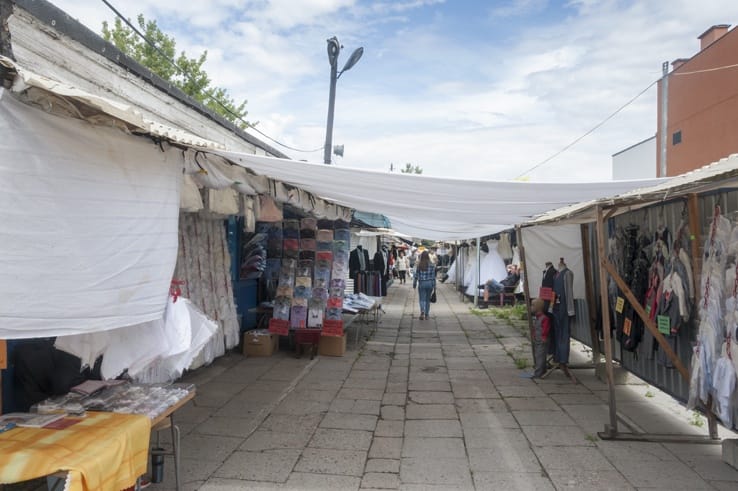
Adam explained that free market is slowly killing the Bazaar. It was thriving during Socialist times, as it was the place where everything could be found. Now, with supermarkets on every other street corner, hardly anyone goes there anymore. In Socialist times, the Bazaar was the only place where capitalism survived. It’s ironic that capitalism is killing it now.
The tour ended at Adventure Warsaw’s very own museum of Socialist memorabilia. Wandering back around Warsaw, we looked at the city with different eyes. We noticed the small things; the bullet holes, the horses’ hooks, the Virgin Mary shrines. Most of all, we saw history. The whole twentieth century.
Our tour was sponsored by Adventure Warsaw. All opinions expressed in this article are our own. We thoroughly enjoyed the tour and recommend it highly.

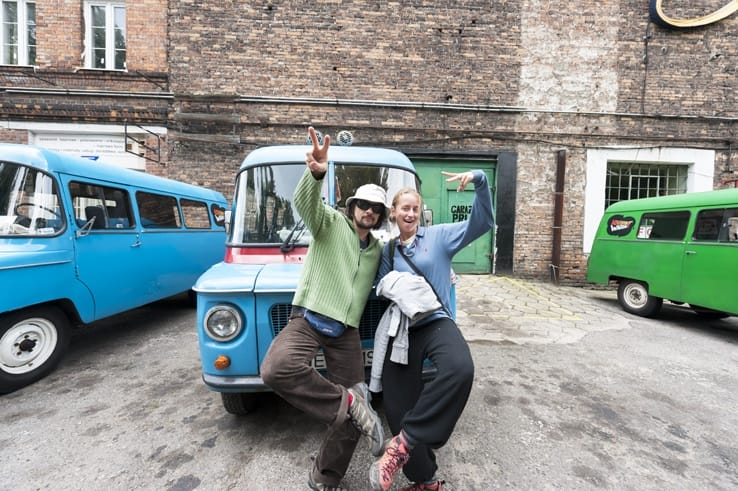
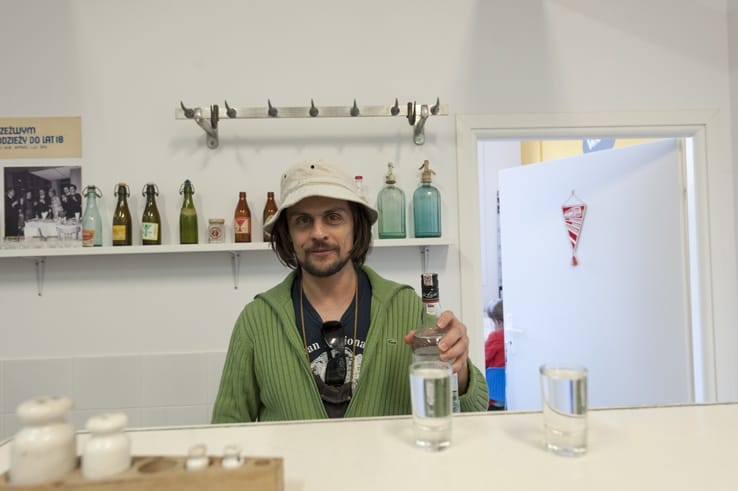

Fantastic post! I’ve heard a lot of negative things about Warsaw from fellow travellers so I didn’t feel too badly about missing it when I was in Poland. I love that you were given the opportunity to see beyond all that and given a view of the ‘ real’ city. May have to give it a try for myself one day. Thank you for sharing 🙂
Great article, thanks for sharing! I’ve been to Warsaw in 2012 and really loved it! As you mentioned, it’s not a typical beautiful city, you have to dig deeper to find its beauty, but it has a great history. I totally recommend Warsaw Uprising Museum.
I’ve been to various Polish city but never to Warsaw. I planned it a lot of times because a dear blogger friend of mine lives there but somehow we never get around to fixing a date we are both around. The van you traveled around in looks so cute, typical Polish I’d say 🙂
Love how you’ve painted Warsaw with your photos! (The wide-angle shot of the Palace of Culture and Science is particularly eye-catching.) I can honestly say that I didn’t have a good first impression of Warsaw (as you mentioned, it seems to be a common thing), mostly due to a run in with an extremely intoxicated fellow in the park outside of the train station. It got better from there luckily, and ten years later, I’m really getting itchy feet to visit Warsaw again and experience more of the city. Will definitely try to fit in some of your suggestions. Thanks!
Great post. As one who grew up in a Socialist country I can relate to a lot of things that you talk about in your article. Hopefully we all learned our lessons from history.
What a beautiful, vibrant and full of history post about Warsaw. It seems that the city is a special mix of all three aspects and you gave me, yet another, reason to travel there. I would love to see what sort of treasures I can find at that bazaar!
Love the wide angle shots.
We love cities that are filled with historical relics. It resonates a lot more than reading a textbook.
Lovely post id love to go to warsaw and dig deep into the history.
I have not been to Warsaw yet but have been meaning to see it for ages now. I want to see it next year for sure.
Amazing post! Some RTW friends of ours couldn’t stop raving about it, telling us we must visit and I can see why. I know it’s really sad, and maybe that’s what draws me to a place that’s borne the brunt of history. Those bullet holes and the sad stories of the buildings really sent shivers down my spine. I’d really like to see it and feel it for myself someday!
What a nice post! Sounds like a great tour too, I like the concept very much. Some cities are just too big for those traditional walking tours..! Interesting history that city has..
I haven’t visited Poland but I really hope I get the opportunity to while I live so close to it. I am obsessed with its history and I have recently read The Pianist which gives a great insight into its history….looks like a great tour to take although I am not always a fan of organised city tours….
You have made the city of Warsaw sound like a living museum. I can see why it would be an interesting place to visit.
I always find walking tours a great way of seeing things you wouldn’t have found otherwise. I haven’t been to Warsaw but it sounds as if it has a fascinating history.
Sounds like I will have to add Warsaw to my bucket list! Especially love the stair photo too x
As a Wroclawian, I have to say that Warsaw is tough city to like, even amongst Poles – all the these recent revitalization projects are steadily making the city more attractive.
Those bullet holes from WWII are really something. Wow… I would love to experience Eastern Europe and get a true feel for the history etched along its walls!
Wow! Great photos, as usual! Warsaw isn’t somewhere I would have a strong interest in going to, but there is so much history there. Looks like a cool tour!
Ok, it seems great to get to experience Warsaw from a different angle. I only briefly visited the city and quite liked it, although nothing stood out too much. I guess I got to come back and see all the fun places you did! Thanks for the tip 🙂
Looks like a great tour and love the van! I haven’t been to Warsaw but your pics are intriguing!
Just goes to show that even the grittier, non-tourist cities are worth a visit.